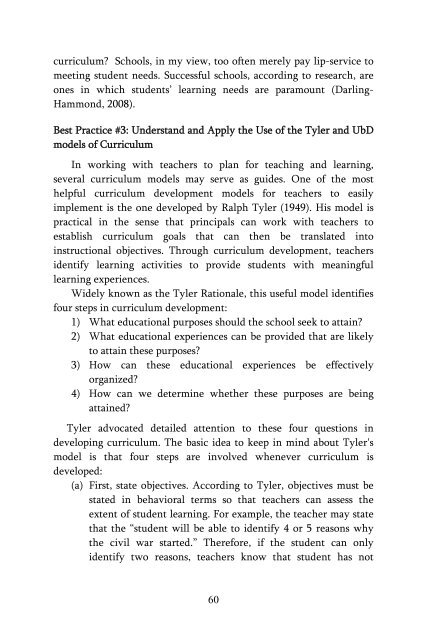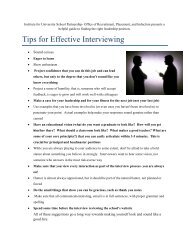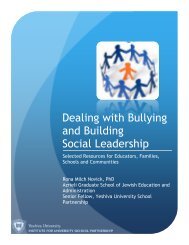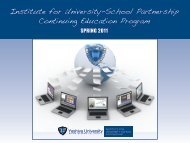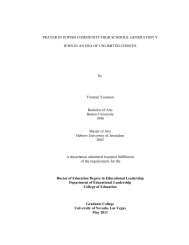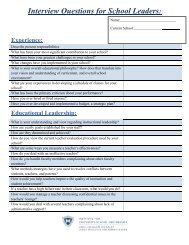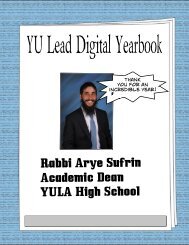Improving Instructional Quality in Jewish Day Schools and Yeshivot ...
Improving Instructional Quality in Jewish Day Schools and Yeshivot ...
Improving Instructional Quality in Jewish Day Schools and Yeshivot ...
Create successful ePaper yourself
Turn your PDF publications into a flip-book with our unique Google optimized e-Paper software.
curriculum? <strong>Schools</strong>, <strong>in</strong> my view, too often merely pay lip-service tomeet<strong>in</strong>g student needs. Successful schools, accord<strong>in</strong>g to research, areones <strong>in</strong> which students’ learn<strong>in</strong>g needs are paramount (Darl<strong>in</strong>g-Hammond, 2008).Best Practice #3: Underst<strong>and</strong> <strong>and</strong> Apply the Use of the Tyler <strong>and</strong> UbDmodels of CurriculumIn work<strong>in</strong>g with teachers to plan for teach<strong>in</strong>g <strong>and</strong> learn<strong>in</strong>g,several curriculum models may serve as guides. One of the mosthelpful curriculum development models for teachers to easilyimplement is the one developed by Ralph Tyler (1949). His model ispractical <strong>in</strong> the sense that pr<strong>in</strong>cipals can work with teachers toestablish curriculum goals that can then be translated <strong>in</strong>to<strong>in</strong>structional objectives. Through curriculum development, teachersidentify learn<strong>in</strong>g activities to provide students with mean<strong>in</strong>gfullearn<strong>in</strong>g experiences.Widely known as the Tyler Rationale, this useful model identifiesfour steps <strong>in</strong> curriculum development:1) What educational purposes should the school seek to atta<strong>in</strong>?2) What educational experiences can be provided that are likelyto atta<strong>in</strong> these purposes?3) How can these educational experiences be effectivelyorganized?4) How can we determ<strong>in</strong>e whether these purposes are be<strong>in</strong>gatta<strong>in</strong>ed?Tyler advocated detailed attention to these four questions <strong>in</strong>develop<strong>in</strong>g curriculum. The basic idea to keep <strong>in</strong> m<strong>in</strong>d about Tyler'smodel is that four steps are <strong>in</strong>volved whenever curriculum isdeveloped:(a) First, state objectives. Accord<strong>in</strong>g to Tyler, objectives must bestated <strong>in</strong> behavioral terms so that teachers can assess theextent of student learn<strong>in</strong>g. For example, the teacher may statethat the “student will be able to identify 4 or 5 reasons whythe civil war started.” Therefore, if the student can onlyidentify two reasons, teachers know that student has not60


